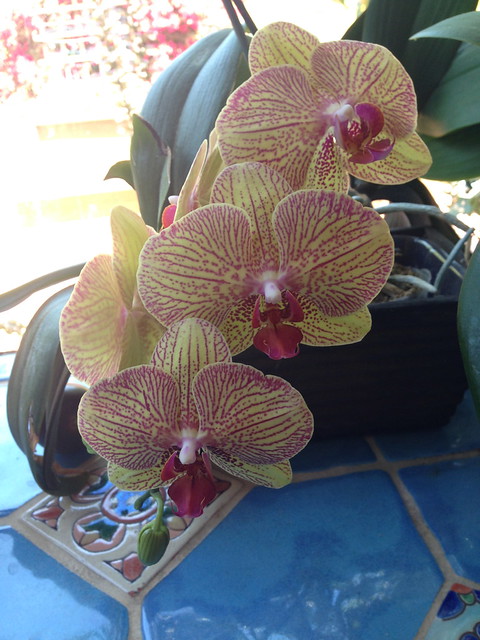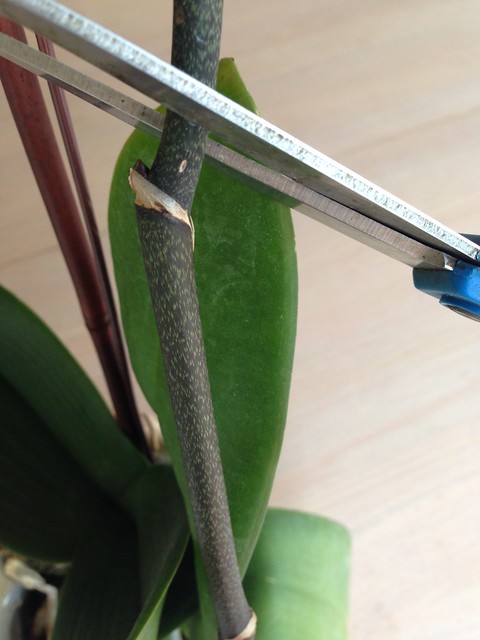The following post was written by my mom, WWW. Thanks, Mom!
I am by complete accident an indoor orchid whisperer, which is really surprising since I have never been successful with houseplants. I don’t
even have any anymore because I was really hopeless at keeping them healthy and
happy—and that includes pothos, ferns, philodendrons and even snake plants, the
easiest of all. I think this has to do
with the fact that I am not a great decorator/organizer/indoor house aficionado
and so my houseplants, when I had them, were neglected the same way that my desk,
closets and cupboards are. Give me any
excuse to be outdoors, on the other hand, and I’m there with fertilizer, water,
and lots of love.
All this being said, orchids (specifically phalaenopsis, or
phals for short) thrive in my kitchen window, so much so that they bloom almost
constantly, year after year after year…and I do, literally, nothing but water
them from time to time. This amazes not
only me, but also my chartreus-thumbed mother who can grow anything—except
phals. Cymbidium orchids outdoors, however, are one of her specialties. Ahem:
As it turns out, success with phals has nothing to do with skill but has everything to do with where they are placed in your house, and it just so happens
that my kitchen window has the exact right ingredients for happy phals. I learned this one evening when I had my
mother to dinner.
“I can’t believe your orchids,” said she. “Mine die and never re-bloom and yours are unbelievable!”
I smiled with pride at my blooming plants, thinking that I must have the magic
touch.
“Yes,” I beamed. “They sure do well for me.”
“Well, that’s because of their location. You happen to have the perfect spot for
them—plenty of light, no direct sunlight, humidity from your cooking, and cool
temperatures at night because they are in a garden window. How often do you
fertilize?”
“Fertilize? Uh….never?”
I replied guiltily.
The next day, I went to the store to buy orchid fertilizer,
which I have had in my cupboard ever since…but have rarely used. Presently, I
have nine blooming phals. Most were
presents. Some were dying plants given
to me by my mother or mother-in-law to bring back to life. All of them are
blooming for the second, third, fourth time…some even more. I have many friends
and relatives who cannot believe my success—who cannot keep them going and end
up throwing them out. And there is
nothing wrong with that. Phals don’t
cost much more than a bouquet of flowers and keep blooming for months, even in
a not-so-perfect spot.
A blooming phal makes a wonderful present—better than a bouquet of flowers that dies in a few days, in my opinion—even if you end up tossing it after it has finished blooming. But if you are interested in keeping these guys going year after year, I am going to share with you what I have learned about them in my years of success.
A blooming phal makes a wonderful present—better than a bouquet of flowers that dies in a few days, in my opinion—even if you end up tossing it after it has finished blooming. But if you are interested in keeping these guys going year after year, I am going to share with you what I have learned about them in my years of success.
Wendy’s very
unprofessional guide to growing and enjoying phalaenopsis orchids:
1.
When buying a phal, look for a healthy plant
that has many unopened buds. This will
ensure that you will have many months of flowers. (One of mine has been blooming NON STOP for a
year!!!!!!)
2.
Put in a location that gets plenty of light, but
not direct sunlight. My window is on the
north side of my house, but has light from above and from the sides, too, since
it is a garden window (a tree outside shades the plants from getting direct
sunlight from the east or west). If you
have your phal next to an east or west-facing window, make sure there is a
sheer drape so it won’t get burned from the sun.
3.
For best results, phals like a small temperature
drop at night, so windows are ideal. (70’s during the day, 60’s during the
night.) Keep them away from forced-air heat. They also LOVE humidity, so if
they are in the kitchen or a bathroom, they will love the humidity gained from
boiling pots of water/soup, or showers.
4.
WATERING:
If your plant is planted in peat moss, let moss dry out before watering
(about every 2 weeks). If it is planted
in bark, water once a week. DON’T
OVERWATER!!!!! Water by putting plant under the tap (tepid water) and letting
it run ‘till the water flows through the bottom, letting the plant sit in sink
until all of the water drains out. Never
let the plant sit in water. (The pot should have a hole in the bottom. If not, the plant is probably potted in an
inner plastic liner. Take the plant out
of the pot to water and then put back in when done.) Also, don’t let the crown
of the plant stay wet or new spikes won’t form.
5.
When all of the blossoms have fallen off the
spike, cut the spike above the second node and it will bloom again in 2-3
months. You can do this several times,
but eventually will want to cut it all the way down to the bottom so another
spike will appear within a year.
6.
If the spot you want to put your phal while it
is blooming does not resemble tip 1 or 2, put them wherever you want, but move
to these conditions after they stop blooming and you’ve cut the spike so that
your phal will bloom again (for instance, you can put them in a bathroom next
to a window to bring them back).
7.
Fertilize (if you remember) with a phalaenopsis
fertilizer from time to time, especially after it has stopped blooming, to
encourage new spikes to form. Again…for some weird reason, my phals do great
without fertilizer because they are by some miracle in the perfect spot.
8.
You can re-pot every couple of years in bark or
sphagnum moss in spring or fall, but I have never done this and it doesn’t seem
to matter.
Love,
WWW







0 comments:
Post a Comment